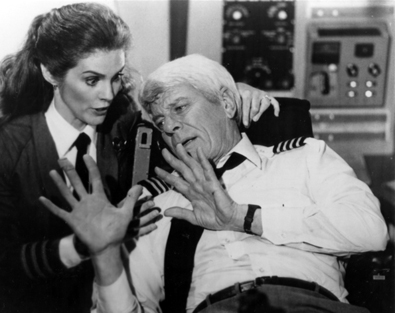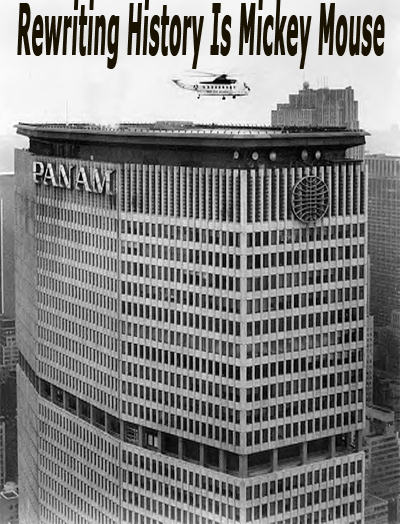
Pan Am the TV show is just
the ticket to beautiful, 1960s airline nostalgia, with crisp uniforms,
warm, inviting pre-terror airport terminals and airplanes, plus lots
of beautiful people in the same place at the same time.
Pan Am is also the first major series
about an airline that has ever been made.
However, while watching the first episode
we were reminded that at its heart, Pan Am is a procedural, made-for-TV
drama that attempts to reach out for as much audience as possible and
winds up being a bit silly as a result.
While all the friendships between stewardesses
(yes, it was ok to call flight attendants stewardesses in the 1960s)
and styling was working like crazy, right down to the crystal martini
glass complete with stirrer and olive served to a passenger up on the
flight deck, the pilots came off as a bit too pretty with nothing much
to say, and when they did speak the show sounded kind of lame.
If anybody knew the legendary pilots of
Pan Am, as a group they were quite distinguished and never trivial like
this TV bunch.
I kept wondering if the pilots were supposed
to be lighthearted, at least the writing could have better.
The late Peter Graves by contrast did
the distinguished-looking albeit laugh out loud pilot perfectly as example.

What’s My Vector, Victor? Peter Graves (pictured here
with Julie Hagarty) played the distinguished. yet hilarious airline
pilot best in the Zucker Brothers movie “Airplane!” |
Also, while we were waiting
for someone to roll out a side of beef and start carving it up for the
travellers on the Pan Am Episode One flight, instead the writers concocted
a silly spy sub plot that was just stupid and made no sense.
Too bad, because on many levels, this
show works.
Pam Am allows the viewer one overriding
truth, and that is the contrast of what air travel once was and is today.
It also gives a window into an era that the public is currently obsessed
with, both in fashion and television: the 60s. We expect the merchandising
for Pan Am-labeled items is about to go through the roof, and don’t
be surprised if you see a lot of blueberry Pan Am stewardesses sashaying
through Halloween.
Particularly moving were the scenes recreating
the lovely and delicate oval terminal Pan Am built at Idlewild (JFK)
Airport during the 1950s.
That building is still in use today by
Delta Airlines and should be seen before it disappears as it is scheduled
to be razed to make way for a new terminal within the next few months,
if not sooner.
We will continue to watch to see the marvelous
style and outright beauty of Pan Am coming through via the stewardesses,
and hopefully that will spread to the flight deck and down on the ground
as well.
Geoffrey
 For
all its high-budget glamour and painstaking attention to details, Pan
Am the TV show cast a purposeful blind eye towards the unseemly side
of the era it depicted. While yes, the 50s - 60s were known for strawberry
matte lipstick, whale bone girdles and the perfect pin curls, all of
which were present in the premier, it was also a time period known for
seedier stuff, and that stuff was glaringly absent throughout the show. For
all its high-budget glamour and painstaking attention to details, Pan
Am the TV show cast a purposeful blind eye towards the unseemly side
of the era it depicted. While yes, the 50s - 60s were known for strawberry
matte lipstick, whale bone girdles and the perfect pin curls, all of
which were present in the premier, it was also a time period known for
seedier stuff, and that stuff was glaringly absent throughout the show.
There were two things I was looking for
when watching the show, and neither of them were delivered. I expected
that a show that revolved around Pan Am stewardesses and pilots would
involve at least one rear-end grab, whistle, or sly remark, but it never
occurred.
How can ABC make a show about this time
period and ignore a societal condition that influenced everything that
came after? There surely would have been a women's movement eventually,
but I think part of what pushed it to the forefront in the 70s was the
mixture of repression and freedom that women of the 40s-60s felt as
a result of going to work during the war, and the afterbleed that occurred
when women continued working and feeling useful in society.
The end result of women working alongside
men in a capacity that allowed them to dress a certain way and, in fact,
exploited their looks to promote a brand, inevitably led to sexism and
sexual harassment, much of which was accepted. So where was the harassment
for all the gorgeous, tightly dressed, perfectly coiffed gals in blue?
The other elephant in the room, or rather,
the flight cabin, was the lack of smoking. Not a single person on the
show smoked a cigarette. Oh wait, the Russian smoked . . . you know,
the guy we're all supposed to hate? He
smoked in-flight, and was alone in doing it. I didn't live through the
time period, but I know enough from hearing from my parents and my friend's
parents that everyone, and I mean everyone, smoked in the 60s. They
smoked in hotel lobbies, airport lounges, cafes, flight cabins, doctor's
offices - pilots would steer Clippers with a Lucky Strike in hand, and
nobody thought anything of it. How can it be that the only person we
have smoking throughout an hour-long period show is a Russian agent
(who turns out to be British)?
Frankly, I found these absences offputting.
I expected to see sexism and cigarettes as part of the story, and without
them there, it felt like a fraud and a farce. I understand - it's ABC,
the television colossus owned by the Walt Disney Company, sometimes
called "The Mickey Mouse Network", and Mickey Mouse wants you to treat
women equally, preserve your lungs and avoid cancer, but that's not
the reality of what was happening during the time period depicted in
Pan Am.
For a show that airs at 10:00 p.m., past
the kiddies’ bedtime, exactly who are you protecting? Why are
you whitewashing history? And not just whitewashing it - you allow one
character to smoke, but it's the character we're supposed to hate. If
you're only going to include smoking to send subliminal messages about
how we should feel about smokers - mainly, that they're evil - don't
bother including the cigarettes.
And if you really want to tell a story
based on events, people, and an airline that actually existed in a well-known
and fairly recent time period, don't pick and choose those elements
you judge are worthy of being included. I'm not a huge fan of George
W. Bush, but I would be a fool to leave him out if I were telling a
story about America between the years 2001-2009. Let us be the judge
- show us everything, and let us decide how we want to feel about it.
It seems Mickey did all the deciding for us.
Flossie
|


 For
all its high-budget glamour and painstaking attention to details, Pan
Am the TV show cast a purposeful blind eye towards the unseemly side
of the era it depicted. While yes, the 50s - 60s were known for strawberry
matte lipstick, whale bone girdles and the perfect pin curls, all of
which were present in the premier, it was also a time period known for
seedier stuff, and that stuff was glaringly absent throughout the show.
For
all its high-budget glamour and painstaking attention to details, Pan
Am the TV show cast a purposeful blind eye towards the unseemly side
of the era it depicted. While yes, the 50s - 60s were known for strawberry
matte lipstick, whale bone girdles and the perfect pin curls, all of
which were present in the premier, it was also a time period known for
seedier stuff, and that stuff was glaringly absent throughout the show.

